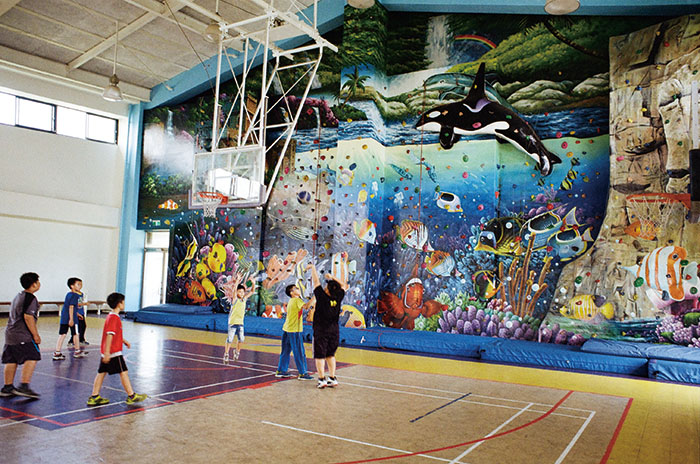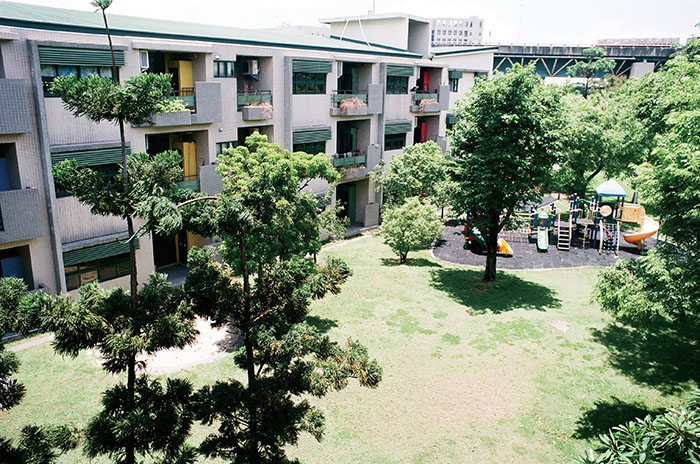Hongmaogang Elementary School Carries the Torch of Hongmaogang's Culture/傳承海港記憶─前鎮紅毛港國小
Hongmaogang Elementary School Carries the Torch of Hongmaogang's Culture
◎English translation: Hou Ya-ting
◎Photos by Jhou Shu-jheng
The colorful, nine-year-old ship-like school building of Hongmaogang Elementary School is located behind the new Taroko Park Mall. Because it is surrounded by more than 100 evergreen trees, the first impression one gets is that of walking into a forest.
The history of Hongmaogang Elementary School goes back to 1924, during the Japanese colonial period. In 1951, Hongmaogang Elementary School changed its name to Haishan Elementary School. Today's Hongmaogang Elementary School disseminates new ideas and information to young people, and the campus carefully preserves tall trees transplanted from the original site of Haishan Elementary School. They are evidence of its cultural achievements and its connection with the past. When the original Haishan Elementary School was demolished in 2007, it moved to a new site, and the old name, Hongmaogang Elementary School, was restored. The school, which now has 92 years of history, resumed enrolling students in August 2008. During break times, students run around a campus full of trees, just as they did in the past.

Director of Student Affairs Mr. Shen You-lin says that when the trees were moved, there were concerns they would not grow well, as the soil at the new site was less salty than at the original site. However, they are now growing even better than before. He goes on to say that transplanting the trees is just one way in which Hongmaogang –a fishing village in Cianjhen District relocated in 2007 to facilitate the expansion of Kaohsiung's port –is commemorated. He explains that the interior design of the school was inspired by Hongmaogang's unique maze-like spaces. The corridors and trails at Hongmaogang Elementary School somewhat resemble the streets and atmosphere of Hongmaogang as a fishing village. By incorporating these features, it is hoped the community and pupils can share affectionate memories of Hongmaogang.
Traces of Hongmaogang can also be found on the two decoration walls inside the campus. Both are works by Mr. Li Yi-syun, an artist and native of Hongmaogang. Mr. Li incorporated elements of sailing rafts, fishing nets, floats, coral, soil, red bricks, as well as portions of artifacts and temple sculptures. Visiting Hongmaogang Elementary School may be the best way to appreciate how local residents endeavor to preserve the fading history and memories of Hongmaogang. Visitors entering the campus should turn right at the school gate so they encounter an "eco-corridor." This features native animals and plants. There is a ship-shaped stone bridge, anchor-shaped chairs by the pond in the square, and then the decoration walls. Taking a close look at these walls, the photographs of Hongmaogang, the old map, the mosaic sculptures by the sink, and Li Shu Library (built to honor Mr. Li Shu, a former teacher) will give visitors an idea of what life in Hongmaogang was like.
The stadium at the back of the campus is the venue for swimming and basketball summer camps. On the second floor of the stadium there is a climbing wall with paintings of marine animals and marine environments as its background. Before they graduate, Principal Mr. Tian Jian-jhong leads pupils through a mini-triathlon, during which they climb 8m, swim 50m, and ride bicycles to the school's old location. This gives the youngsters unforgettable memories.
The corridor around the swimming pool is lined with red bricks, a common building material in old Hongmaogang. Pupils chat with their friends in red-brick corridors of various heights. Every corner of this green campus and the trees which encircle it are connections to the old roots of Hongmaogang.
傳承海港記憶─前鎮紅毛港國小
◎文、攝影/周書正
紅毛港國小藏身在前鎮草衙道背後的森林裡,「森林」是這座才落成九年的新建學校給我的第一印象,周圍百棵遠比它年長的南國樹種,綠意包覆著色彩鮮豔的船型校舍。
紅毛港國小前身是紅毛港地區的海汕國小,從日治時期「大林蒲公學校紅毛港分教場」算起,已經超過九十年歷史。之後隨著政府拆遷,學校跟著紅毛港人一起搬進鳳甲重劃區,並在2008 年8月招生。
沈佑霖主任告訴我,紅毛港國小不只接續原校學生與歷史,也延續原鄉的樹。較高大的老樹大多自海汕國小移植,帶著紅毛港百年故事住進新家,下課時便把孩子擁進懷裡,在他們耳邊吹起記憶的風。
 「原本擔心樹移植後沒辦法適應,沒想到從鹽分高的土壤搬到這,反而長得更好。」沈主任說 。老樹遷入只是紅毛港國小努力保留紅毛港記憶之一,跟著它們一起說故事的,是整間學校處處可見的空間規劃巧思。「學校保留原來紅毛港裡彎來彎去的意象,走廊、步道很少看到有筆直的線條,把這些融在建築裡,就算再過五、六十年,小朋友及社區都能保有這個記憶。」沈主任接著說。
「原本擔心樹移植後沒辦法適應,沒想到從鹽分高的土壤搬到這,反而長得更好。」沈主任說 。老樹遷入只是紅毛港國小努力保留紅毛港記憶之一,跟著它們一起說故事的,是整間學校處處可見的空間規劃巧思。「學校保留原來紅毛港裡彎來彎去的意象,走廊、步道很少看到有筆直的線條,把這些融在建築裡,就算再過五、六十年,小朋友及社區都能保有這個記憶。」沈主任接著說。
紅毛港出身的藝術家李億勳,特地以「帆筏、魚網、浮筒、硓(石古)石」和「泥土、紅磚、器物、廟宇雕刻」組合而成兩面紅毛港意象牆。從校門右側生態池出發、走過介紹在地動、植物的遮蔭廊道、踩過有船型石板橋與船錨型座椅的池邊廣場,再探訪紅毛港意象牆,便是完整的紅毛港環境、產業、人文的巡禮。從紅毛港照片、舊地圖、洗手臺上獨特的立體馬賽克雕塑、到紀念前海汕國小教師的李澍紀念圖書館,一點一滴都是紅毛港記憶的重建與再現。
走進建築群中的體育館,孩子們正分別參與游泳和籃球夏令營。體育館二樓的一側,是整片海洋世界彩繪的攀岩牆。孩子們畢業前,田建中校長會帶領他們進行攀岩8公尺、游泳50公尺及騎單車回紅毛港尋根的「小鐵人三項」,把紅毛港對孩子們的期許與記憶,深深刻印在他們的童年裡。游泳池外的紅磚廊道,用的是紅毛港從前常見的清水磚,在廊道裡組成高矮錯落的紅色圍籬,讓身高、年紀各異的孩子們能在這裡遮蔭談天 。
在綠建築校園裡,紅毛港國小成功地將關於歷史記憶與聚落情感的思索,鑲嵌進每一個角落。